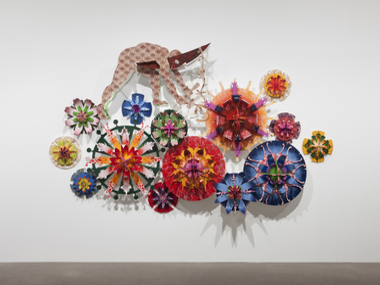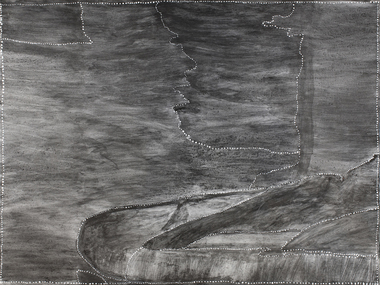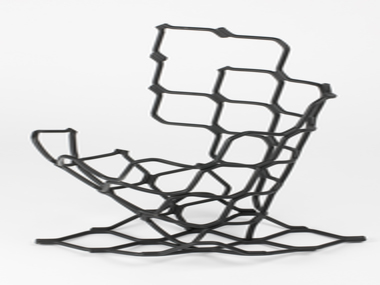WA AWARDS SPRING A SURPRISE

The winner, Brian Robinson's '…and meanwhile back on earth the blooms continue to flourish', 2013. Wood, plastic, steel, synthetic polymer paint, feathers, plant fibre and shell, 200x350x50cm Artwork courtesy of the artist and Mossenson Gallery
Posted by Jeremy Eccles | 23.08.13
Gallery: Art Gallery of WA
Dates:
23.08.13
: 12.01.14
Oh Boy, they must be crowing in Queensland! In Perth, a Queenslander took out the Big One – actually, the country's biggest Indigenous art award of $50,000; and behind him were 2 fellow Sunshine Staters. In Darwin two weeks ago, the Painting and Works on Paper awards both went the same way. It would be nice if someone told Premier Campbell Newman that his predecessor's generous investment in Indigenous art developments such as the Cairns Art Fair and new art centres had paid off so handsomely!
And Brian Robinson is the man for the West – a Torres Strait Islander who – like many – came to Cairns, learnt to make spectacular prints, became a curator at the Regional Gallery, and has now accumulated so much art wisdom that he can surprise in just about anything he does. Greek myth, nautical lore, plastic flowers and positively conceptual titles are all his his grasp today.
The WA judges – former curator Hetti Perkins, academic John Barrett-Lennard and local Indigenous curator Clotilde Bullen were in accord: “Brian’s work reveals images portrayed in the great tradition of the Renaissance frescoes that have been recast with traditional characters from the Torres Strait Islands. Aspects of the stories of Ulysses are brought to life in a frenzied ocean, which features a boat caught in an octopus’s tentacles. In addition, da Vinci’s flying machines are embodied in the paper planes that attempt to escape from their two-dimensional counterparts on the surface. His mighty ancestral beings wear masks through which lightning comes as the conduit between men and gods, and there are multiple symbols of good and evil.”
My friend Nicolas Rothwell would not be happy! The Australian's major writer on the art of the North has waxed eloquent of late about all that's going wrong in Aboriginal (and TSI) art. The core of his case is that a well-funded bureaucratic (and academic) apparatus is swamping the creativity of what he calls 'traditional' artists, taking them away from the origins of that art in ceremony and law in order to produce conformist, large-scale art that mimics the non-Indigenous mainstream. Much of this, he claims is the ALP Government's fault, having imposed Resale Royalty, a Code of Conduct and ludicrous restrictions on investing in art for superannuation funds on the natural flow of the industry.
And when it came to the NATSIAAs, it was clear that works taking off from the traditional like Robinson's were a disappointment and a descent from “the golden treasure of Aboriginal ideas and forms” that dominated the early days of those 30 year old awards.
In Perth he'd have found not only Robinson's innovation, but Abe Muriata's wire and plastic versions of the cane baskets of Rainforest Queensland that he used to weave in cane, more of Dulcie Sharpe's soft sculptures from the Alice Springs town camps, Laurence Omeenyo's lumpy Lockhart River pottery, and Beavor Lennon's glowing canvas landscapes, a polymer Namatjira in irradiated Woomera.
So six out of 16 finalists, picked by the judges and then (like the RAKAs in Melbourne) encouraged to select a representative portfolio of recent work, emerged from traditional communities and chose to take their art out for a walk. Is that reflective of the national trend, I wonder?
Take comfort, Mr Rothwell in the seven who remain true – headed for me by the always interesting Wintjiya Napaltjarri from Papunya Tula, but headed for the judges with his selection as the WA State award winner, the East Kimberley/Gija man, Churchill Cann from Warmun. Also there are the subject of recent Rothwell feature, Nora Wompi, Ray Ken and Ngipi Ward from the colourful but lore-abiding APY Lands, Wukun Wanambi from Arnhem and Conrad Tipungwuti from Tiwi and an unknown (to me) but shimmering Minyawe Miller from the Pilbara.
Here's the Cann citation: “Churchill Cann has a distinctive visual language within the Warmun vernacular. In his purposeful documentations of country, he seems to strip back the surface of the land to reveal its (almost corporeal) structure. Composed by balancing translucent and opaque areas of ochre, his paintings are organic and dynamic. The small dotting, and the thicker edges where the ochre and earth pigments meet, lend the works a line-drawing or sketch-like quality. In Buffalo Hole, Cann demonstrates his extraordinarily skilful use of colour as well as his command of charcoal, which appears to have been blown by wind across the canvas like air across water. As it does in all of Cann’s works, his material finesse conjures images of a sentient land, one that is primeval yet still in the process of creation. Ultimately, it is his ability to inspire wonder at what lies beyond the human experience that makes him a worthy winner”.
And then there are the frequently nominated but so far unsuccessful Yhonnie Scarce and Christian Thompson. I'm pretty sure that Tasmania's Julie Gough was making her unlucky debut.
As a relative outsider to Indigenous art, Art Gallery Director Stephano Carboni – from Italy but, latterly, an Islamic art expert in New York – has an interesting take on these Awards:
“The WA Indigenous Art Awards were founded by the Western Australian Government in 2008. From that time until 2011 they were held annually. This is the first of the Art Gallery of Western Australia’s biennial presentation of the Awards.
"The two-year period between these and the last Awards has given us at the Gallery the
opportunity to reflect upon what they have brought to both the WA arts community and the national arts scene. In looking at their past, it is clear to me that the Awards not only play an important role in providing opportunities for artists, but have done much to increase the knowledge and appreciation of contemporary Indigenous art. As such, they remain the cornerstone of the Gallery’s engagement with this vibrant area of cultural practice.
"The Awards’ impeccable reputation has been built on the quality of work exhibited in previous years and the expertise that each panel has brought to the selection process. What also makes them special is the diversity and breadth of work that the selection model allows the Gallery to showcase. Its format requires the Awards curator to travel around the country meeting with artists, communities and artists’ representatives. This year has been no different, and exposure to the diverse Indigenous arts scene has been instrumental in providing the platform for the Gallery to strengthen relationships and promote genuine engagement with this country’s varied Indigenous arts communities. Importantly, it also makes for an Awards event and exhibition grounded in an intimate knowledge of the field.
"Thanks to this rigorous process, the overall winners from 2008 to the present – Patrick Tjungurrayi, Ricardo Idagi, Wakartu Cory Surprise and Gunybi Ganambarr – and the Western Australian winners – June Walkutjukurr Richards, Wakartu Cory Surprise, Sonia Kurarra and Jan Billycan – truly represent the ultimate in artist achievement in this country. Each of the winners is highly regarded by their peers and communities, and I am very happy that the Gallery has been able to feature and support their practices through the Awards.
Above all, I am extremely grateful to the 16 artists who have accepted the invitation to participate as finalists in the Awards exhibition. Hailing from across Australia, they are truly exceptional artists. Their inspirational work ensures that the Awards continue to surprise, challenge and beguile our viewers. As they do so, this year’s Awards continue the tradition of past Awards in unveiling the brightest and most captivating Indigenous artists currently at work in this country”.
It's sad that so few folks from OE (Over East) will get to see this compilation in the flesh to fully understand what he means. But you can go online a vote for the People's Choice, which ought to be a more positive experience than events on September 7th!
URL: WA Indigenous Artists Awards, Art Gallery of WA
Share this:
»  del.icio.us
»
del.icio.us
»  Digg it
»
Digg it
»  reddit
»
reddit
»  Google
»
Google
»  StumbleUpon
»
StumbleUpon
»  Technorati
»
Technorati
»  Facebook
Facebook
Contact Details
Gallery: Art Gallery of WA
Email: admin@artgallery.wa.gov.au
Telephone: +61 8 9492 6600
Address: Perth Cultural Centre Perth Perth 6000 WA
Gallery: Art Gallery of WA
Email: admin@artgallery.wa.gov.au
Telephone: +61 8 9492 6600
Address: Perth Cultural Centre Perth Perth 6000 WA

Churchill Cann, 'Buffalo Hole' 2012, natural ochres and pigment on canvas 90.0 x 120.0 cm. Courtesy of the artist and Warmun Art Centre

Abe Muriata's 'recycled Jawun', 2013, screen-mesh 41.0 x 32.0 x 20.0 cm. Courtesy of the artist and Girringun Artists
Where is the exhibition?
Further Research
Gallery: Art Gallery of WA
Artists: Abe Muriata | Beavor Lennon | Brian Robinson | Christian Thompson | Churchill Cann | Conrad Tipungwuti | Dulcie Sharpe | Gunybi Ganambarr | Jan Billycan | Julie Gough | June Walkutjukurr Richards | Laurence Omeenyo | Minyawe Miller | Ngipi Ward | Nora Wompi | Patrick Tjungurrayi | Ray Ken | Ricardo Idagi | Sonia Kurarra | Wakartu Cory Surprise | Wakartu Cory Surprise | Wintjiya Napaltjarri | Wukun Wanambi | Yhonnie Scarce
News Tags: Jeremy Eccles | Mossenson Gallery | Nicolas Rothwell | Stefano Carboni | WA Art Gallery | WA Indigenous Art Awards
News Categories: Art Prize | Australia | Event | Exhibition | Industry | Other Event
Exhibition Archive
- 10.10.17 | TARNANTHI 2017
- 11.08.17 | Natsiaas 2017
- 20.07.17 | APY ART DOMINATES THE WYNNE
- 17.07.17 | Anangu Artist Wins $100,000 Prize
- 14.07.17 | The End of AAMU
- 11.07.17 | ART ACROSS THE COUNTRY
- 11.07.17 | TARNANTHI IN OCTOBER
- 05.07.17 | TJUNGUṈUTJA - from having come together
- 13.06.17 | Ghost-Nets Straddle the World
- 07.06.17 | Grayson Perry Going Indigenous?
- 05.06.17 | Barks Bigger than Ben Hur
- 27.05.17 | NGA QUINQUENNIAL 2017
- 21.05.17 | Blak Douglas Finds Home at the NGA
- 21.05.17 | BRIAN ROBINSON WINS HAZELHURST WOP
- 18.05.17 | PARRTJIMA 2.0
Advertising

